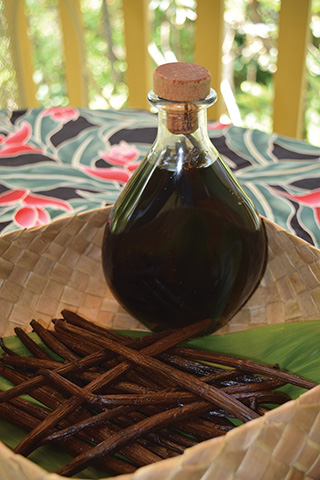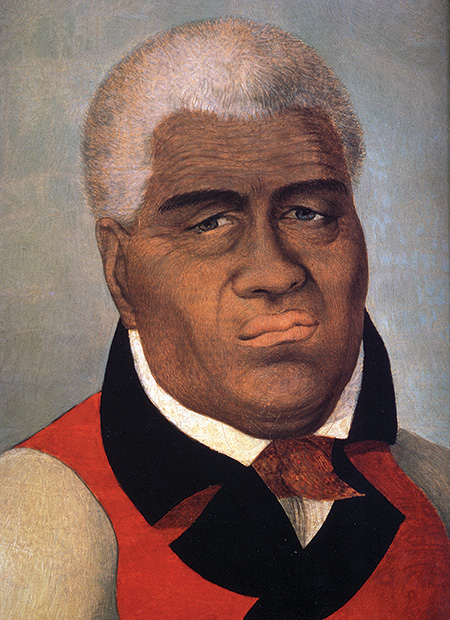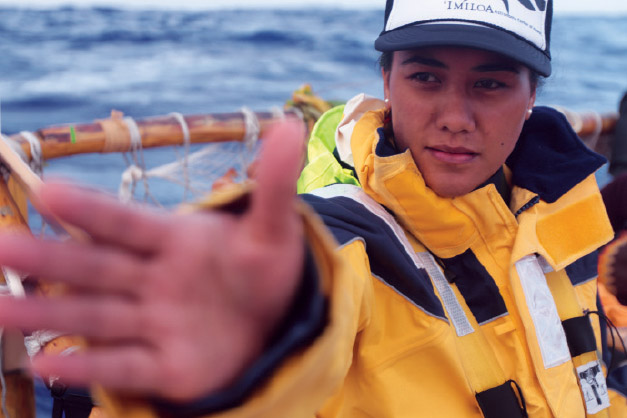
Keau‘ohana Forest Restoration
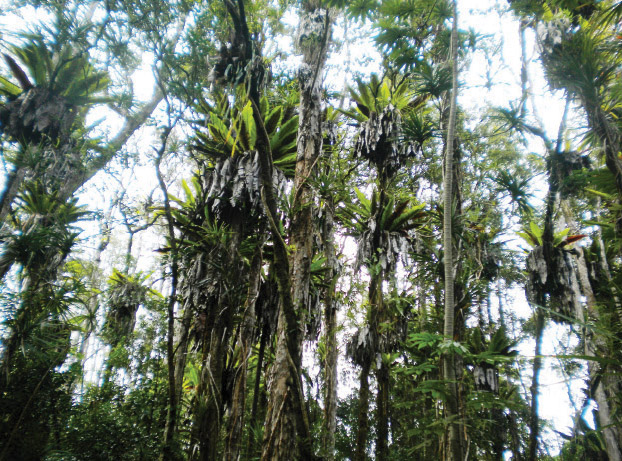
By Mālielani Larish
A strawberry guava tree quivers as Jaya C. Dupuis tugs at its roots, freeing them from beneath a mossy log. One stubborn root remains anchored to the earth, so she follows it to a cluster of young native kōpiko seedlings. Kneeling down, she gently extracts the strawberry guava’s root without disturbing the neighboring kōpiko.
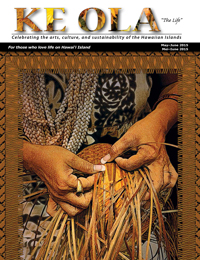
Jaya bundles the strawberry guava together with other invasive plants and hauls them to a neatly stacked compost pile. Looking up and inhaling deeply, Jaya absorbs the thriving life of Keau‘ohana Forest Reserve that has inspired her actions for the past six years. ‘Ie‘ie vines spiral up ‘ōhi‘a trees while ‘apapane birds dart between crimson ‘ōhi‘a lehua blossoms. ‘Ēkaha ferns hug tree trunks at multiple heights, glowing a verdant stained-glass green. Yellow ‘amakihi fly down to investigate the 20 or so volunteers who are working alongside Jaya to remove invasive plants from this Puna reserve.
Since July of 2014, Jaya has organized and facilitated monthly volunteer days to help restore the native rainforest of Keau‘ohana Forest Reserve.
Keau‘ohana—which translates to “group of families” or “familial currents”—is the largest and most intact lowland wet forest below 1,000 feet remaining in the state of Hawai‘i. A multitude of native plant species flourish in this forest, including the endangered ha‘iwale (Cyrtandra nanawalensis).
Most of Hawai‘i’s lowland wet forests have been replaced by agriculture and residential development. Other forest experts who recognized the value of Keau‘ohana’s unusually intact habitat began restoring a small section of the forest in 2005. However, they only met on a quarterly basis and did not pursue any funding for the project at that time.
Jaya completed a Master’s Degree from the University of Hawai‘i at Hilo in 2012 with the specific aim of doing restoration work for Hawai‘i’s lowland wet forests. Ann Kobsa, a dedicated lowland wet forest steward and friend, inspired much of Jaya’s focus.
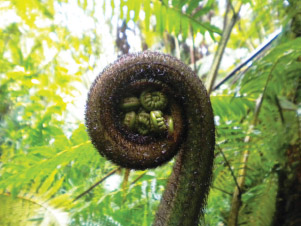
Jaya’s study, which examined vegetation patterns in Puna’s five lowland forest reserves, prioritized the Keau‘ohana Forest Reserve as an ideal candidate for restoration. The data revealed that forests growing on 200 to 750-year-old lava flows contained higher native species richness, more rare native plants, and the fewest number of invasive species when compared to younger and older flows. The Keau‘ohana restoration area consists of a substrate within this intermediate range.
Jaya developed a restoration plan and wrote a grant proposal to restore about 100 acres on the makai (ocean) side of Keau‘ohana. Several local conservation agencies rejected her proposal.
Undeterred, she worked with State Senator Russel Ruderman to submit her grant proposal to the legislature of the State of Hawai‘i. The state’s Grant-in-Aid program approved the request in 2014. With the help of County Council member Greggor Ilagan, Jaya also secured county contingency funds to purchase project supplies.
The grant monies will allow Jaya to hire a crew of part-time workers who will systematically remove invasive species and plant native species in the targeted restoration area. In addition, the grant funds will enable her to continue managing monthly volunteer efforts, which she has facilitated out of her own pocket up until now.
In the meantime, volunteers keep returning for the welcoming community atmosphere of the monthly volunteer days.
Laughing and talking, a knot of volunteers reenters Keau‘ohana to assist with outplanting on the afternoon of a volunteer workday. Carrying potted ‘ohe plants, they step carefully to avoid the native groundcover springing out of the moss and rock. The ‘ohe plants will grow up to 80-feet tall and provide important shade for plants below.
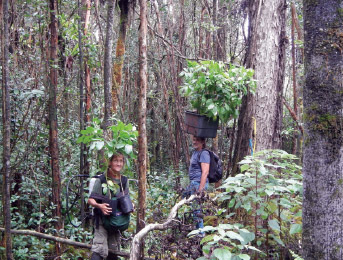
In their quest for good outplanting spots, the volunteers meander through the lush understory: neon-green moss cushions sparkling with raindrops, hāpu‘u ‘i‘i tree ferns covered with furry hairs, māmaki plants prized for their antioxidant properties, and kōlea trees sporting rosy new leaves. The endangered ‘io (Hawaiian hawk), which relies on mature ‘ōhi‘a forests like Keau‘ohana, calls a shrill “eeeeh-oh” overhead.
After finding a good spot that has some open canopy, one of the volunteers carefully moves ‘a‘ā lava rocks to create a hole for the plant. He looks around, perplexed as to where he is going to find soil to fill the hole. His partner arrives with the answer: rich black humus scooped from the heart of a decomposing ‘ōhi‘a stump. They nestle the humus into the hole to nurture the young ‘ohe.
These and other local native plants are grown at the Hawai‘i Reforestation Program greenhouse, which is run solely by volunteers. David Anderson donates the space for the greenhouse, while Ann Kobsa, Mark Hanson, and several others donate supplies, labor, and time spent collecting seeds in Puna’s lowland forest reserves.
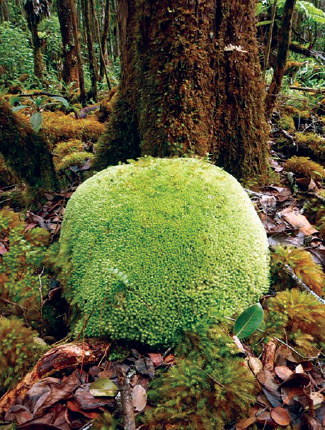
Led by Dana Keawe, a volunteer kitchen crew prepares and serves a free lunch for the workdays. Most of the ingredients are donated, organically grown, and locally sourced. The onolicious spread includes dishes like kalua pig, cassava hash browns, octopus poke, avocado, and papaya and rollinia for dessert.
It is easy for the community to access Keau‘ohana because it is located along Highway 130. Drivers zoom past the reserve every day, but they can’t see the magical native ecosystem hidden behind a thick wall of strawberry guava.
“All the monthly efforts have been very successful,” Jaya observes, noting that volunteers have weeded about a quarter of an acre on each volunteer day.
“Māmaki is coming in strong. It is being spread by the birds in areas that we have opened up,” Jaya says. In restored areas “there are also a ton of kōpiko keiki. This is good because kōpiko may become the primary canopy species in the forest if we lose the ‘ōhi‘a to the Ceratocystis fungus.”
Last year, scientists identified the Ceratocystis fungus as the culprit in the mysterious deaths of ‘ōhi‘a in the Puna district. In areas where large canopy trees like ‘ōhi‘a are lost, invasive species can rapidly gain a foothold by taking advantage of the extra light.
Jaya plans to continue holding monthly volunteer days and applying for grant funding. She would like to bring more groups into Keau‘ohana to learn about its native forest ecosystem, which she believes is an “essential representation of the past.”

The native plants of Keau‘ohana arrived in the isolated Hawaiian archipelago hundreds of thousands of years before humans via wind, wings, and water. Hawaiians consider the natural life forms of the forest (and in fact, all of nature) as kinolau, or body forms of the deities. ‘Ie‘ie, maile, and ‘ōhi‘a lehua, which all grow in Keau‘ohana, were picked for the hula altar as kinolau of the hula goddess, Laka. Hawaiians wove the strong and flexible adventitious roots of the ‘ie‘ie vine into fish traps, baskets, and feathered helmets for warrior chiefs.
The loss of Keau‘ohana, Jaya says, would be “a tragic one in terms of the forest community and individual species therein, but also in terms of our understanding and enjoyment of this unique resource.”
The restoration of Keau‘ohana Forest Reserve is a labor of love, community, and urgency. As one Hawaiian proverb reminds us, Hana no‘eau ke aloha—love is wise work. ❖

The monthly volunteer workdays meet on the third Sunday of the month from 9:30am-4:30pm. Volunteers may come and go as they like. A check-in tent is set up between mile markers 16 and 17 on Highway 130 at the intersection of Pāhoa-Kalapana Road and Upper Puna Road. Volunteers are advised to bring gloves, sturdy shoes/boots, rain gear, mosquito repellant, water, and snacks. The trail into the forest is just across the highway from the intersection.
For more information contact Jaya C. Dupuis.
Contact writer Mālielani Larish.
Sources:
Anderson-Fung, P. and K. Maly. Hawaiian Ecosystems and Culture. College of Tropical Agriculture and Human Resources, 2002. Online pdf.
Dupuis, Cindy J. Vegetation Patterns in Lowland Wet Forest of Hawai‘i. University of Hawai‘i at Hilo Master’s Thesis, 2012.
Hall, John B. A Hiker’s Guide to Trailside Plants in Hawai‘i. Mutual Publishing, 2004
